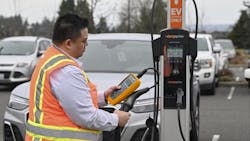Charging Anxiety: Why EV Infrastructure Depends on Maintenance, Training, and Standards
Key Takeaways
- Charging anxiety is now the primary barrier to EV adoption, emphasizing the importance of reliable, accessible charging stations.
- Current public charging station reliability is below federal standards, with only about 84% success rate, highlighting the need for improved maintenance and standards.
- Predictive maintenance, remote monitoring, and advanced diagnostics are essential strategies to reduce downtime and enhance charger reliability.
- A skilled, certified workforce supported by ongoing training and standards-based tools is critical for maintaining high-quality charging infrastructure.
Electric vehicle (EV) adoption in the United States is no longer hypothetical. Nearly one in ten new car sales last year were either fully electric or plug-in hybrid, and globally the figure has already passed 20%. Consumers are showing clear demand, and automakers are committing hundreds of billions to electrification. The transition is underway.
What is less certain is whether the charging infrastructure can keep pace. Vehicles continue to improve in range and performance, and consumers are more willing than ever to make the switch. Yet without reliable, accessible, and well-maintained charging stations, momentum could falter.
From Range Anxiety to Charging Anxiety
For years the dominant barrier was “range anxiety.” Would an EV have enough battery to cover a daily commute or a long road trip? That worry is fading. Many vehicles now exceed 300 miles on a charge, several new models exceed 400 miles, and more than 80% of EV owners plug in at home overnight.
The new concern is “charging anxiety.” The question is no longer “Will my car make the trip?” but “Will I be able to find a working charger when I need one?” It is a shift that moves the focus away from the vehicle and onto the reliability of the infrastructure behind them.
The data confirms why drivers feel this way. A study in the San Francisco Bay Area found that only about 72.5% of public fast-charging stations with CCS connectors were functional, with problems ranging from broken connectors and short cables to payment failures and unresponsive screens (Rempel et al., 2022). Nationally, J.D. Power reported in early 2025 that public charging attempts succeed only 84% of the time, meaning almost one in six attempts ends in frustration (J.D. Power, 2025).
No other part of the transportation system could tolerate that level of unreliability without losing public trust. The federal NEVI program requires 97% uptime for chargers receiving funding, which puts these performance numbers in stark perspective and highlights how far operators must go to meet regulatory expectations.
The Reliability Gap
Tesla’s Supercharger network stands out for its reliability, consistently ranking near the top for uptime and user satisfaction. But because access remains restricted to Tesla and a limited number of partner brands, it cannot serve as the foundation for the broader market.
If EV adoption is to scale at the pace that automakers and policymakers expect, reliability must become universal. That means any driver should be able to pull into any charging station, regardless of vehicle make or model, and expect it to work. Initiatives such as CharIN and the ChargeX consortium are pushing interoperability standards and running cross-platform trials. Progress is visible, but technical standards alone will not solve the problem. The industry also needs systematic maintenance practices and a skilled, evolving workforce to be able to uphold those principles in real time.
Maintenance as a Reliability Strategy
Much of the downtime at charging stations comes from preventable issues, making predictive maintenance increasingly critical as the industry grows. Effective strategies require a balance of reactive maintenance — responding quickly to vandalism, collisions, and unexpected failures—and preventive maintenance, which builds resilience into daily operations. Predictive maintenance goes further by leveraging data and analytics to identify problems before they lead to outages. This need is reinforced by a recent Fluke survey: 36% of respondents cited charger maintenance as a top industry challenge, 44% pointed to inoperable chargers as a major hurdle, and 40% flagged software incompatibility. Compounding these concerns, 88% highlighted a critical workforce skills gap, underscoring the urgency of investing in training and development to enable more advanced maintenance practices.
Preventive work should include remote monitoring of charger performance, scheduled inspections of safety systems such as ground-fault interrupters and emergency stops, regular servicing of cooling systems and power electronics, and testing of payment systems. Firmware updates are another critical element: too often these are deployed without adequate release notes or advance warning, leading to unrecognized error codes that confuse maintenance teams and frustrate drivers. Remote analytics are especially valuable. They give operators 24/7 visibility into charger status, reduce unnecessary site visits, and allow failures to be diagnosed before users encounter them.
Standards and Tools
Servicing EV chargers is technically demanding. It requires a workforce trained to original equipment manufacturer (OEM) specifications, armed with advanced diagnostic tools, and working under consistent standards. Without that alignment, outcomes vary, maintenance costs increase, and the inconsistency breeds consumer frustration.
I believe in “putting the expert in the box.” That means embedding standards-based methodologies and pass/fail criteria into the test instruments themselves. Even a frontline technician can then verify safety and functionality against international standards, without needing to know every detail of each regulation. This helps from a skills shortage perspective too, as it's helpful for new entrants to market. By democratizing best practices, the entire industry can raise its baseline for productivity and reliability with safety at its absolute core.
Building the Workforce
Tools and standards, however, cannot substitute for skilled people. A dependable charging ecosystem relies on a trained and continually certified workforce. The Electric Vehicle Infrastructure Training Program (EVITP), supported by groups such as the International Brotherhood of Electrical Workers, has already certified more than 20,000 technicians. That is a strong start, but demand is many times greater.
Technology is not static. Firmware updates, higher-power charging, and advanced thermal systems change the skill requirements every year. Training must evolve accordingly, so operators and their maintenance providers must see workforce investment as inseparable from infrastructure investment. Without enough qualified people, the best hardware will still underperform.
Aligning Incentives Through Service Agreements
Technical capability alone is not enough. Operators and service providers need contractual frameworks that tie performance to consumer experience. Service level agreements (SLAs) are the tool for this. Well-crafted SLAs set expectations for response times, resolution targets, and uptime guarantees.
Transparency is equally important, maintenance teams must have access to diagnostic codes, error logs, and performance data, ensuring they are not left troubleshooting in the dark. When operators and service partners share visibility, systemic problems can be identified and solved before they spread. This level of visibility should be contractually required, so that operators and service providers are working from the same real-time information rather than reacting to incomplete reports.
Designing for the Future
Every new charging station built today must be designed with long-term reliability in mind. That means requiring equipment certified to ISO and IEC standards, mandating compliance with the Open Charge Point Protocol (OCPP) for roaming and interoperability, demanding proactive firmware updates with proper documentation, ensuring OEM-certified training for service providers, and structuring warranties and contracts so that uptime, not replacement or minimal compliance, is rewarded.
Contracts and warranties should be separated, even when the OEM is also the service provider, so that incentives are aligned toward uptime rather than replacement. Future-proofing decisions made at the procurement stage directly affect reliability years later. A charger that meets higher standards from the outset is less likely to become a liability for operators and more likely to deliver the seamless experience that drivers expect.
Why Uptime Matters
At its core, EV adoption depends on one simple metric: uptime. Every unavailable charger undermines trust, every failed session adds to charging anxiety, and every instance of charging anxiety slows vehicle adoption.
The industry is successfully tackling range anxiety by delivering longer-range vehicles and expanding home charging. It must now bring the same urgency to the charging infrastructure. That requires treating maintenance, training, and standardization as essential pillars of infrastructure development rather than afterthoughts.
If the sector succeeds, the charging experience will feel as seamless and dependable as refueling a gasoline vehicle, which is the threshold consumers expect. And when that happens, the full potential of electric mobility will finally be unlocked.
About the Author

Theo Brillhart
Theo Brillhart serves as the Technology Director at Fluke Corporation’s Research and Development division, where, for over 16 years, he has played a pivotal role in advancing innovative technologies. With extensive expertise in high-tech product development and growth acceleration, Theo leads a team of Senior and Principal Engineers focused on technology exploration, new product creation, and the establishment of global industry standards.
He has been deeply involved in developing international standards, collaborating with prominent organizations such as IEEE, SCTE, the Ethernet Alliance, SAE, and CharIN, while also making significant contributions to global standards through his involvement in multiple ISO and IEC technical committees.
